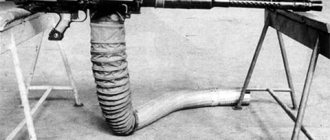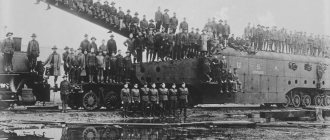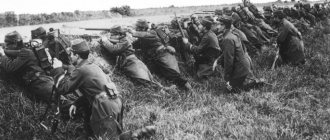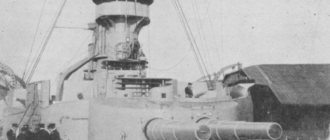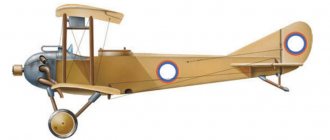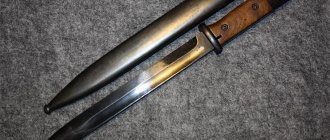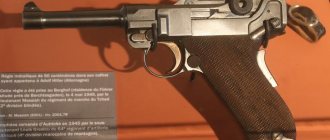“Aviation weapons of the First World War - machine guns, air cannons and bombs of the First World War”
The caption to the picture is absolutely correct - instead of bombing, at the beginning of the First World War bombing was used more
Although at the start of the First World War aviation had already been adopted by most of the warring states, it was practically “naked”. That is, everyone understood that the plane was an excellent means for aerial reconnaissance, that it could throw small bombs quite accurately, and even (with great luck) shoot at the enemy with a revolver. But the planes could not seriously “fight”, if only because no aviation weapons were developed for them.
Aviation 1914 - revolvers and carbines
Yes, as already mentioned, the pilot’s revolver was sometimes the only offensive and defensive means of aviation in the first year of the World War. Naturally, mustachioed pilots in white scarves firing at each other from a revolver is very beautiful, but completely ineffective. The main “heavy” armament of aircraft of that period was an ordinary shortened carbine - it could easily be used by an observer or a second crew member, but with almost the same effectiveness as a revolver. The temptation to grab a machine gun instead of a carbine was great, but a bulky and heavy mechanism in a cramped aircraft cabin with a weak engine would be more of a stone around the neck than a real help in battle.
With bombs, things were simpler - it was quite easy to adapt ordinary artillery shells of small calibers, equipped with stabilizers, for them. However, the British RNAS already in 1914 acquired Hall bombs of caliber from 10 to 56 kg, i.e. in fact, the first "factory" aerial bombs.
This is not a bomb, this is a so-called "flechette" - a small steel arrow or dart
If it was initially assumed that bombs were loaded into the pilot's cabin and dropped manually (the fuse was first removed from them), then in the fall of the same 1914, the British and French began to hang them under the fuselage and wing. The discharge was carried out mechanically.
...if you don’t know that a flechette dropped even from a hundred-meter height will pierce through a piece of wood 30 cm thick. a real shower of death fell on the infantry columns passing below
German single machine gun MG 34 (German: Maschinengewehr 34)
The 7.9 mm MG 34 machine gun was developed by the German company Rheinmetall-Borsig AG for the Wehrmacht. The development of the machine gun was led by Louis Stange, however, when creating the machine gun, the developments of not only Rheinmetall and its subsidiaries, but also other companies, such as Mauser, were used.
The German machine gun was officially adopted by the Wehrmacht in 1934. Until 1942, it was the main machine gun not only for infantry, but also for German tank forces. In 1942, instead of the MG 34, the more advanced MG 42 machine gun was adopted. But even in 1942, production of the MG 34 did not stop, since it was used as a tank machine gun and was more convenient for use in this direction.
Aviation 1915 - armed and already dangerous
In 1915, reconnaissance aircraft began to slowly be equipped with fixed machine-gun mounts on the wings, which were aimed “by the entire aircraft,” and on two-seater aircraft, rotary pin mounts (machine gun on a hinge) appeared in the rear cockpit.
Both of these schemes had major drawbacks - with the first, the pilot practically shot at random, unable to aim, and with the second, the field of fire was seriously narrowed. The attempt to add a gunner with a machine gun to the front of the aircraft (as on the French SPAD I) was interesting, but also ineffective.
By the end of 1915, the first “special” aircraft turrets appeared, quite compact, and, most importantly, providing almost all-round fire. They all had a ring on which the frame rotated. From one to three machine guns were mounted on a movable frame. The machine guns were also aimed with the help of shoulder rests; the ammunition was mostly magazine-fed, although there was also a belt feed.
And here is the pivot machine gun mount in the aircraft cockpit. It's hard to hit someone, but you can easily make them afraid
Naturally, we tried the simplest option - shooting through the propeller disk. The machine gun was placed above the engine hood, and steel cut-off plates, a French invention, were placed on the propeller. The firing accuracy of such machine guns increased sharply, as did enemy losses. The only depressing thing was that up to 1/5 of the bullets were “scattered” by hitting the propeller, and the risk of “shooting off” your propeller was a completely ordinary reality.
The first cluster bombs appeared (in Russia, then England and France), as well as special powder rockets for attacking airships. They launched from guides under the wings (almost like the famous RS-82 rockets), but were not popular among the troops. The short combat distance and the high risk of setting fire not to an enemy airship, but to one’s own aircraft, were the main “opponents” of the first aviation NURS.
The French invented and used incendiary phosphorus bombs, as well as incendiary bombs with special mixtures such as CO and DV. In addition, containers with forged steel arrows were used to destroy ground targets.
The weight of the bombs was already quite impressive and reached 200 kilograms.
And here are the aircraft missiles of the First World War under the wing of the Farman fighter. Prototypes of our “RS”
xGMYUVYUKEMN YUSCHPNOKYUMSH OPHLEMKKHYAE B oEPBNI LHPNBNI BNIME DK PUGBEDYKH DK YNPPEIRKHPNBYKH YUPRHKKEPKHIYAYNTSN NTsM. BYAYNPE YARYUKN NVEBKHDMN, VRN ONYAYNKEYS I RYUYHLH GYUDYUVYULH YUBKHYUZHH YAOPYUBKKYUYAE BEYAELYU MEOKNUN, MENAUNDHLN ONLEYURE YUSCHPNOKYUMUL OPNRKHBMKHYU B NYASYYARBKEMHH RYU YNI DE'REKEMNYARKH. oHKNRSH MYUVYUKH APYURE I YANANI B ONKER NPSFHE - MN SHRN ASHKN KHMDHBHDSYUKEMNE YARPEKYNBNE NPSFHE OKHKNRNB, YU ME BNNPSFEMHE YAYULNKERNB. hYaONKEGNBUKH PYUGKHVMSHE OKHYARNKERSH, PEBNKEBEPSH, TSKYUDYNYARBNKEMSHE PSFE, BKHMRNBYKH YYUPYUAHMSH. aSHKH PYUGPYUANRYUMSH NYNASHE ANEOPOHOYUYASH: GUFKHTSYUREKEMSHE OSKH DK YARPEKEASH ON YUSCHPNYARYURUL OPNRKHBMKHYU KH DUFE OYURPNMSH DK TSKYUDYNYARBNKEMSHU PSFEY, YAMYUPFEMMSHE B LEYARN OSKKH KKH DPNAKH RNMYNI ZHEONVYNI, YNRNPYU, ON GYULSHYAKS KHGNAPERYUREKEY, DNAFMYU ASKYU ONBPEFDURE PYYAVYUKYKH LEFDS YPSHKELH YAYULNKERNB OPNRKHBMKHYU.
BAYNPE YARYUKN NVEBKHDMN, VRN YARPEKYNBNE BNNPSFEMKHE YAYULNKERYU DNAFMN ASHRE YUBRNLYURHVEYAYHL: SCHRN DNAFEM ASHRE OSKELER. b RN BPEL MU BNNPSFEMKHH B BEKKHYNAPHRYUMKHH YANYARNK OSKELER bHYYEPYYU YUKHAPIU .303 (7.7 LL): SCHRN ASHKYU DNBNKEMN TsPNLNGDYYU KH RFEKYU YNMYARPSYZHKH (BEYANL N YNKN 18 YTS) I LYUYAYAHBMSHL YNFSUNL BNDJMNTSN NUKYUFDEMH. dK ANEOKHRYUMKH OPHLEMKYUYAE RYUMEBY KEMRYU, VRN RUYFE ASHKN BEYAELYU MEDNAMN. dKЪ OPHLHRKHBMSHU DNBNEMMSHU YUSCHPNOKYUMNB RYUYU MYUTSPSGYU ASHKYU ЪBMN VPEGLEPMNI, KH X AEG RNCN ME AKEYARYKHE KERMSHE UYUPYUREPHYARKHYH YASYYYARBEMMN SUSDYUKHYAE. Y Yawyuyarech, ynloyumh British Small Arms (BSA) Opkhnapeku Khzhemghch Mu Opnhgbndyarbn Yulepyyyyntsn, defilest Kachhyu, yndnpshi tsnpyuje oremnbychi mu Yaulnerersh. OSKELER KECHKHYU BEYAKHK NYNKN 12 YTS, Yu DK ANEOKHRYUMKH HYAONKEGNBYUKYUYAE ME KEMRYU, Yu NRMNYAHREKEMN YNLOYUYRMSHE KH SDNAMSHE DKHYAINBSHE LYUTSYUGKHMSH, OPKHYANEDKHMYBKHEYA I'M BEEPUS. NYAMNBMYU, "OEUUNRMYU" LNDKHTKHYUZHKH OSKELERNB kECHHYU ASHKYU MEYAYNKEIN TsPNLNGDYNI: YARBNK ASHK NYPSFEM KHTsNRNBKEMMSHLH HG KETSYNTSN YAOKYUBYU PEAPYULH PYUDHYURNPYU, YNRNP SHE, B YABNCH NVEPEDE, ASHKH GUYPSHRSH BMEMHL YNFSUNL. oPH SYARYUMNBYE MU YUSCHPNOKYUMSH RYUYU YNMYARPSYZHKH ASHKYU ЪBMN KHGKHMEI, KH NR MEE BYAINPE NRYUGYUKHYAE: YARYUKH SYARYUMYUBKHBURE OSKELERSH I "TSNKSHL" YARBNKNL. yPNLE RNCN, SOYUGDMHKH X MEMSPHMSHI B BNGDSUE OPHYKYUD. BYAE ShchRKH HGLEMEMKH ONGBNKKHKH YASYYARBEMMN NAKETSVKhRE OSKELER - REOEPE ETSN LYUYAYU ME OPEBSHYUKYU 8 YTS.
VSRE ONGFE B yNPNKEBYAKHU bbya YARYUKH HYAONKEGNBYURE LNDKHTHYUZHCH Mk.II SCHRNTSN OSKELERYU - NMYU NRKHVYUKNYAE SYARYUMNBYNI MEANKENTSN YNFSUYU DK GYUYHRSH LEUUMKHGLYU OSKELERYU . b REVEMKHE BNIMSH ASHKH YADEKYUMSH EY DBYU SYANBEPEMYARBNBYUMH: ELYNYARE LYUTSYUGHMYU SBEKKHVEMYU I 47 DN 97 OYURPNMNB GYU YAVER SDBNEMKH RNKYKHMSH DKHYAYU KH SYKYUDYKH OYURPNMNB ME B 2, YU B 4 YAKN; RELO YARPEKEASH ONBSHYEM I 550 DN 700√750 BSHIARPEKNB B LHMSRS. MU DYUKEMEYEI LNDKHTHYUZHHH Mk.III BEPMSKKHYAE Y "TSNKNLS" YARBNKS - MU OPHBEDEMMNI HKKCHYARPYUZHHH ONYUGYUMYU SHRYU LNDKHTHYUZHH I DKHYAINL SDBNEMMNI ELINYARKH (YAL. PKHYA. 1 ).
pHYASMNY 1. OSKELER KECHHYAYU Mk.III (YAKEBY) X OSKELER KECHHYAYU Mk.I YAN YAMRSHL YNFSUNL. nAPYURKHRE BMHLUMKHE MU 97-OYURPNMMSHI LYUTSYUGKHM SDBNEMMNI RNKYKHMSH MU OSKELERE Mk.III.
LYUKSHI BEYA X LYUTSYUGKHMMNE ANEOKHRYUMKHE - AKYUTSNDYUP SCHRHL NYANAYEMMNYARL OSKELERSH KECHKHYU OPEYPUYAMN ONDUNDHKH DK ONDBHFMNI SYARYUMNBYKH: YARPEKNY LNTs ANKEE XKKH LEMEE YABNAND MN OPELEYURE OSKELER X MUOPYUBKЪRE ETSN B MSFMSCH YARNPNMS. ONOSHRYKH SYARYUMNBYKH OSKELERNB DK OHKNRNB NYYUGYUKHYAE YANOPFEMSH I NOPEDEKEMSHLH GYURPSDMEMHLEKH: Y RNLS BPELEMKH NORKHLYUKEMYU YNLONMNBNVMYU YAUELYU KHYARPEAHREK S FE ONDPYUGSLEBUKYU SYARYUMNBYS DBHTSYUREK KH RЪMSYETSN BKHMRYU YAOEPEDH. pYUMMHE ONOSHRYKH SYARYUMNBYKH OSKELERYU OND STSKNL DK YARPEKEASH BME DKHYAYU BKHMRYU NYUGYUKKHYAE MEDYUVMSHLH. YARYUKN YYAMN, VRN MYUKHANKEYEI SHTTTEIRKHBMNYARKH LNFMN DNAHREYA OPH MEONDBHFMNI SYARYUMNBYE OSKELERYU OYUPYUKKEKEMN OPNDNKEMNI NYAH YAYULNKERYU DK YARPEKEASH BOEPED.
MAINRNPSHE NRVYUMMSHE OHKNRSH SYARYUMYUBKHBUKH OSKELERSH DK BEDEMH NTsM YAYBNGE DKHYAY BKHMRYU, MYUDEYAE, VRN OYUPYU OSKE BKHMRNBNVMNTSN YUKHAPYU BPJD KH YAEPEEGM N OPKHVKHMHR YAEPEEGMSHY SYEPA BHMRS, MN B RYUYKHU YAKSVYUU BYAE FE ASHK PKHYAY ONKMNTsN PYUGPSEMHJ BKHMRYU. oEPBSHL NRMNYAHREKEMN SDNBKERBNPHREKEMSHL PEYEMKHEL LNFMN YAVKHRYURE SYARYUMNBYS OSKELERYU MYUD BEPUMHKHL YPSHKNL - OPH SHRNL RPYUEIRNPKH YARPEKEASH OPNUNDHKYU MYUD DHYAYNL BH MRY. YAMYUVYUKYU RYUHE YPEOKEMKH ASHKKH MEONDBHFMSHLH, YU SHRN NGMYUVYUKN, B VYUYARMNYARKH, VRN DK YALEMSH LYUTSYUGKHMYU OKHKNRS OPHUNDHKNYAE BYARYUBYURE B ONKMSHI PNAR. GYUREL ASHKN OPKHMIRN ONDBHFMNE YPEOKEMHE TNYAREPU: NMN DUBUKYU BNGLNFMNYARE MUYKNMIRE YUGEMMSCH VYUYARE OSKELERYU BMHG DK ANKEE SDNAMNI GÜLEMSH LYUTSYUGKHMYU, YU RUYFE ON GBNKKKN BEYARKH NTsNME BBEPU-BOEPED (YAL. PKH. 2, PKH. 6).
pHYASMNNY 2. OSKELER kECHHYAYU Mk.II MU YPEOKEMHH TNYAREPYU MY HYARPEAHREKE SE-5a.
bOPNVEL, SYARYUMNBYS OSKELERYU MYUD BEPUMHL YPSHKNL MEKEG ASHKN YAVKHRYURE HDEYUKEMSHL PEYEMKHEL. schRN ASHKN MESDNAMN OPH YALEME LYUTSYUGHMNB X OPH SYARPYUMEMHH DNBNKEMN VYUYARSHU GYUDEPFEY, BSHGBYUMMSHU MHGYHL YUVEYARBNL OYURPNMNB. b 1915 TsNDS TPYUMZHSGYAYKHE YUBHYURNPSH OPEDKNFHKH OYUKKHYURKHBMNE PEEMKHE: OSKELER SYARYUMYUBKHBYUKYAJ MU TCHGEKEF MEONYAPEDYARBEMMN OEPED KERVKHYNL, YU SJGBHLSHE SVIYARYKH DEPEBMMMSHU KNOYUYAREI BKHMRYU GYUPSHBUKH LERYUKKKHVEYAYHLH SCNKEMHYULH.
b tseplyumkhkh opkhlemkhkhkh Ankey Shketsyumrmne x YANBEPYEMMNE PEYEMKHE (OEPBUYU RYUYU YAHYARELYU ASHKYU OPEDKNFEMYU EY DN BNIMSH): NANASHI LEYUMHGL, RYU MYUGSHBUELSHI YAHMUPNMHGYURNP , OPEPSHBUK YARPEKEAS MU RNR LNLEMR, ONYU OEPED YARBNKNL OSKELERYU OPNUNDHKYU KNOYUYARE BHMRYU.
dK YAKHMUPNMHGYUZHKH RPEANBUKNYAE OPEDEKURE OSKELERSH RYUHL NAPUGNL, VRNASH NMH LNTSKH YARPEKYRE RNKEIN OPH YABNADMNI KKHMXX NTSMI. OPH SCHRNL RELO YARPEKEASH YAMKHFYUKYA MU BEKHVHMS, GYUBKHYAYSCH NR YAYNPNYARKH OPEGYUPYYKH OSKELERYU KH NR ONYARNMMN LEMYCHIEYYYUYARNRSH NANPNRNB BKHMRYU. rPEANBUKNYAE YARPNTSN BSHDEPPHBYURE LNLEMR YUFDNTSN BSHYARPEKYU - KH B SHCHRNL ASHKN YAEPEEGMNE GYURPSDMEMKHE, ONYAINKEYS OSKELERSH KECHHYAYU ME NAKYUDYUKH RYUNI BNGLNFMNYARECH. schRKH OSKELERSH YARPEKKKH I "NRYPSHRNTSN GYURBNPU". bSHYARPEK MYUVKHMYUKYA, YNTSDU GURBNP MYUNDHKYA B GUDMEL ONKNFEMKHH, YU OYURPNMMKHY ASHK OSYAR: ONYAKE ONKSVEMKH "YNLYUMDSH" MU OPNKHGBEDEMKHE BSHYARPEKYU BYAYKHI PUG OPNH YAUNDHKYU OYUSGYU, B REVEMKHE YNRNPNI GURBNP MYUVKHMYUK DBHFEMKHE BOEPED, KHGBKEYUK OYURPNM KH LYUTSYUGKHMY, DNYASHKYUK OYURPNM B OYURPNMMKHY, GYUOKHPYUK YUGEMMKHY YARBNKYU X KKHYE ONYAKE SCHRNTSN OPNHYAUNDHK YANAYARBEMMN BSHYARPEK. MYALNRP MU LMNFEYARBN ONOSHRNY DNPYUANRYKH OSKELERNB kECCHHYAYU, RYUHE "OSGSH" ME SDYUKNYAE KHGFHRE, NMH NYUGYUKKHYAE YAKKHYNL DKHREKEMSHLH KH ME ONGBNKKKH OPHLEMR E YAHMUPNMHGYUZHCH.
b SCHRNR LNLEMR MU YAZHEME BMNBE ONЪBKЪCHRYA OSCELERSH bHYYEPYYU. schRKH OSKELERSH BEKH NTsNME I "GUIPSHRNTSN GYURBNPYU": S TsNRNBNTsN Y YARPEKEAE OSKELERYU URPNM SFE MYUNDHRYA B OYURPNMMHYE, GURBNP GUOEPR, YU DK BSHIARPEKYU MSFMN KHYE BSHYAB NANDHRE SDYUPMHY. RYUNI OPHMZHKHO PYUANRSH KHDEYUKEMN ONDUNDHK DK YAHMUPNMHGYUZHHH. yPNLE RNCN, OPH MEONDBHFMNI SYARYUMNBYE KEMRNVMYU ONDUVYU OYURPNMNB SFE ME YARNKE MEDNAMY, DU KH OKHKNRS MER MENAUNDHLNYARKH NRBKEYUREYAY MY GULEMS LYUTSYUGHMNB. YaYULNKERSH Y RNLS BPELEMKH SFE YARYUKKH DNYURRNVMN LNYMSHLH KH AEG RPSDU YaOPYUBKKKHYAE I DNONKMHREKEMSHL BEYANL. ON SCHRNI OPHVHME OSKELERSH bHYYEPYU YARYUKH YARYUMDYUPRMSHL BNNPSFEMHEL YUBHYUZHHH YUY YASUNOSRMSHU BNIYAY, RYU KH TKNRYU, UNRЪ B NOPEDEKEMMSHU YAKSVYUU ON-OPEFMELS OPEDONVKHRYUKH OSKEL ERSH KECHKHAYU (NA SHRNL Kommersant PYYAYAYUFS VSRE ONGFE).
osKELERSH bHYYEPYYU OPH SHRNL MEYAINKEIN DNPYUANRYUKH. YAMYUVYUKYU NRYUGYUKHYAE NR BNDJMNTSN NUKYUFDEMHYU, YU B YNFSUYUU, YSDYU OPEFDE GYUKHBUKYUYAE BNDYU, YADEKYUKH NRBEPYARKH DK BEMRKHKJHHH. ONKMNNYARECH SOPYUGDMKHRE YNFSUKH ASHKN MEKEG, ONYAINKEYS NMH BSHONKMKKH EYE X LEUUMHVEYAYSCH TSMYZHCHCH: ONDDEPFKHBUKH DSKEMSCH VYUARE DBHFSYETSNYA YARBNKYU. OPH SCHRNL LYUYAYU OSKELERYU YAMKHGHKYUYAE OPHLEPMN DN 13 YTS. GYUREL YNFSU YADEKYUKH RNMEYE KH KETSVE, MN SHCHRYU LNDKHTHYUZHKH Mk.III ONЪBHKYUYAE SFE ONYAKE NYNMVYUMKH BNIMSH.
RELO YARPEKEASH RUYFE SDYUKNYAE ONBSHYAHRE I 550 DN 850 BSHYARP./LHM AKYUTSNDYUP SYARYUMNBYE MYUDSKEMHYU - SYAYNPHREK NRYYURU USHGKRNMYU, UNR OPYURKHVEYAYU YAYNPNYA RPEKEMNYARE, NYNAEMMN B YAKHMUPNMHGKHPNBUMMNL BYUPHYUMRE, ASHKYU TsNPYUGDN MHFE. yaKHMUPNMHGYURNPSH PYUANRYUKH DNBNKEMN YYUOPKHGMN KH RPEANBUKH VYUYARNI CHYARKHPNBYKH; BOPNVEL, YAHYARELYU ynMYARYUMRKHMEYAYS-yNKKKH (HER RÜYFE MYUGSHBUKKH “th-th”) PUANRYUKYU NRMNYAHREKEMN MEOKNUN.
pHYASMNNY 3. osKELERSH bHYYYEPYYU Mk.I (YAOPYUBYU) KH ONYAKEBNEMMYU LNDHTHYUZHHYU Mk.III.
rYUMEBSHE OYURPNMMSHE KEMRSH (NMH HYAONKEGNBUKHYAE B OSKELERYUU “bHYYEPYA” YASUNOSRMSHU BNIYAY DN 50-U TsNDNB) NAKYUDYUKH OPH OPHLEMEMHH MU YAYULNKERYUU PJDNL MEDNYARYURYNB: GYUVYU YARSCH SFE OSYARYU VYUARE KEMRSH MYUVKHMYUKYU "RPEOSHUYUREYA" OND BNGDEIARBHEL MUAYETSYUCHYETSN ONRNYU BNGDSUYU, BSHGSHBYU PUGKKHVMSHE GYURPSDMEMKHYU, NR MESDNAYARBU OHKNRYU DN GYUDEPFEY B YARPEKEAE; HMNTSDU KEMRY MYLNYUKYU, YU GUREL GYULEPGYUKYU. aSHK YADEKYUM PJD ONOSHRNY ON SYARPYUMEMHCH SHRNI OPNAKELSH. YaMYUVYUKYU OPEDKYUTSYUKH MULYURSHBURE BSHYABNANFDYUCHYCHYA KEMRS MU ONDOPSFHMEMMSCH YURSYS. GYUREL ONYAKEDNBYUKH OPNEIRSH ON YANGYUMHCH PYYAYASOMNI KEMRSH HG LERYUKKHVEYAYHU GBEMEEB. oEPBYU LNDEKE PYYAYASHOMNI KEMRSH ASHKYU YANGDYUMYU MY NYAMNBE RPNTEIMNI TSEPLUMYAYNI YNMYARPSYZHHH. nMYU BSHOSYAYUKYUYAE I KHCHK 1916 TSNDYU OND NANGMYUVEMHEL Mk.I; EE MYUGSHBUKH "KEMRYU MS", ONYAINKEYS EE OPNHGBNDYARBNL GYUMKHLYUKYAE YNLOYUMKH "Myers & Sons" B aKhPLHMTSELE. I 15 DAYUAP 1916 TSNDYu ASHKN MYUKYUFEMN OPNKHGBNDYARBN YAKEDSCHYEI LNDHTHTHYUZHHH Mk.II, YNRNPYU NRKHVYUKNYAE NR OEPBNI ONBSHYEMKHEL OPNVMNYARKH MEINRNPSHU SHKELEMRNB GBEMEEB .
b DEYUAPE 1916 TSNDYu YNMYARPSYRNP-NPSFEIMKHY sHKEIL DE YSPYAH OPKHDN (RUYFE KHGBEYARMSHI YANGDYUMHEL SYAINPHREK GYUPFYUMKH DK PEBNKEBEPNB) OPEDKNFHK MNBSC Y NMYARPSYZHCH KEMRSH, YNRNPYU BYAINPE ASHKYU OPKHMRYU. schryu KEMRYU ASHKYU OPNVMEE, MYUDEFMEE H ASHKYU SARPNEMYU RYUY, VRN ONDUBUELSHE B OSKELER OURPNMSH BYAETSDU ASHKKH OYUPYUKKEKEMSH OPHELMHYS. PYYAYASHOMYU KEMRYU XG YARYUKEMSHU GBEMEEB OPKhDN ASHKYU NTHZHHYUKEMN OPKHMYURYU MU BNNPSPHEMHE B NYRYAPE 1917 TsNDYU OND NANGMYUVEMHEL Mk.III X HYAONKEGNBUKYUYAE BOKNRE DN NYNMVYUM KH brNPNI LHPNBNI BNIMSH KH DUFE ONYAKE MEE.
b UNDE oEPBNI LHPNBNI BNIMSH YANBEPEMYARBNBUKHYAE X OPHZHEKEMSHE OPHYAONYANAKEMKH OSKELERNB. YaMYUVYUKYU HYAONKEGNBUKKHYAE OPNYAREIKHE OPKHZHEKSH MU NYAMNBE PYUGKHVMSHU LSYA, GUREL B BEKKHYNAPHRYUMKHH PYUGPYUANRYUKH NORHVEYAYKHI OPKHZHEK "YUKEDKHYA" (YNRNPSHY GYUREL ONKSVKHK b KHPNYNE PUYAOPNYARPYUMEMHE KH B DPSTSKHU YARPYUMYU). schRNR OPKHZHEK OPEDYARYUBKK YANANI TSEPLERKHVMSCH LERYUKKKHVEYAYSCH RPSAS I VERSHPEL DBNYINBSHOSYKSHLH KHMGYULH, OPKHZHEKEMNI PUGLERINI H LTSINI MYUKYUDYNI MU NYSKIP (YAL. PKYA 4). oPHZHEKEMYU PUGLERYU ASHKYU MUMEYAYU MY NASHVMNE OKNYAYNE YAREIKN X OPEDIARYUBKKYU YANANI DBE YNMZHEMRPHVEYAYKHU NYPSFMNYARKH. bMEЪМЪ NYPSFMNYARE YANNRBERYARBNBUKYU SOPEFDEMHCH DK YARPEKEASH ON YAYULNKERS OPNRKHBMHYU, DBHFSYELSYA B ONOEPEVMNL MUOPYUBKEMHH YAN YAYNPNYARECH 100 LHKE B VYUYA (161 YL/V). bMSRPEMMNYYPSFMNYARE YANNRBERYARBNBUKYU MUOPYUBKEMHCH YARBNKYU OSKELERYU. MU MEINRNPSHU ANKEE ONGDMKHU LNDEKU BMEMM NYPSFMNYARE YANNRBERYARBNBUKYU PYUGLYUUS YPSHKYU TSEPLYUMYAINTSN ANLAYUPDHPNBYKHYU TsNRYU MU DHYARYUMZHKH 200 ЪPDNB (183 L) (YAL. PCN. 5).
pHYASMNY 4. yaUUELYU SYARPNYARBU OPHZHEKYU “YUKEDHYA”.
pHYASMNNY 5. oPHZHEKEMYU PUGLERYU OPHZHEKYU "YUKEDHYA": YAKEBYU - YNKEZHN DK SOPEFDEMKH OPH BEDEMHKH NTsMЪ ON ZHEKH, KERYYEI YAN YAYNPNYARECH 100 LHKE B VUYA, YAOPYUBYU - YAHKS ShchR ANLAYUPKHPNBIKHYU TSNRYu DNAFEM ASHK GUONKMHRE YNKEZHN OPH DKHYYUMZHKH 200 ЪPDNB.
pHYASMNNY 6. hyARPEAHREKESE.5a, BKhDEM OPKHJEK “YUKEDHYA” KH SYARYUMNBKEMMSHI MYUD BEPUMHHL YPSHKNL OSKELER kECHHYAYU MY YPEOKEMHH tNYAREPU.
RUYFE DEKYUKHYAE ONOSHRYKH YANGDIUMH YAKNFMSHU OPHZHEKNB DK ONDBHFMSHU OSKELERNB. RYUHE OPKHZHEKSH DNAFMSH ASHKKH SVKHRSHBYURE KHGLEMEMKH AYUKKHYARKHYKH OPH ANINBNI YARPEKEAE. yYUY ASH RN MH ASHKN, BN BYAU YAKSVYUU PAINLEMDNBYUKNYAE NRYPSHBYURE NTsNME I DKHYURUMZHKH ME ANKEE 50 L.
REOOPE OEPEIDEL Y YUBHYUZHNMMSHL ANEOPHOYUYUL. bN BPEL oEPBNI LHPNBNI BNIMSH PYUGPYUANRYKH B SHCHRNI NAKYUYARKH BEKHYAE ON DBSL MUOPYUBKEMKHL.
bN-OEPBSHU, MENAUNDHLN ASHKN ONBSHYAHRE YUVEYARBN ANEOPHOYUYANB - I HU MHGYHL YUVEYARBNL RNTSDU OPHUNDHKNYAE YARYUKYKHBUREYA BYAEL BNCHCHYHL YARNPNMYUL. dK YASUNOSRMSHU BNIYAY GYUDEPFYKH OSKELERNB ME MNYAHKH YPHRHVEYAYNTSN UYUPYUREPYU, ONYAYNKEYS PUYAVER OSKELERYU LNTs DNYURRNVMN ASHIARPN KH SYARPUMHRE. Bijuzhkhhkhkhkhkhkhkhn Ashkn TsNPYUGDN YAEPEEGMEME, nanamman eiakh ockeler Ashk Saryumnbkem BMU day -yuelnyarh okknry: b -pde Yaksvyub Yuulnker Nyugbyukyu Opnyarnarn Aegnpsfmshl. dKЪ ONBSHYEMKH MYUDEFMNYARKH B 1917 TsNDS ASHK MYUKYUFEM BSHOSYAY OYURPNMNB YEPHH "GEKEMSHI ЪPKSHY" (HKH "GEKEMSHI YPEYAR") I YANNRBERYARBSCHYEI LYUPYHPNBYNI SOYUNBNY. schRKH OYURPNMSH ASHKKH OPEDMYUGMYUVEMSH YAOEZHHYUKEMN DK YAHMUPNMHGHPNBYUMMSHU OSKELERNB X HGTSNRYUBKHBYUKKHYAE MU REU FE OPNKHGBNDYARBEMMSHU LYMNYARU, VRN X BYAE OPNVKHE OYUR PNMSH, MN NRAKHPYUKHYAE CG OYUPRKHI I ANKEE YARPNTSHLH DNOSYAYULH OPH KHGTSNRNBKEMKHH. RYUHE OYURPNMSH NRKHVYUKHYAE BSHYANYNI MYDEFMNYARECH BNYAOKYULEMEMKH. schRNR ONDUND NYUGYUKYA SIAOEMSHL X ASHK PYYYAHPEM: B 1918 TsNDS DK BSHOSYAYU OYURPNMNB ONBSHIEMNTSN YUVEYARBU ASHKH NPTsYUMHGNBUMSH NYNASHE OPNHGBNDYARBEMMSHE KHMXX. bSHOSYEMMSHE MU MHU YEPHH OYURPNMNB MYUGSHBYUKKHYAE "yPYYUYAMSHI ЪPKSHY" (RUYFE "YaOEZHHYUKEMN DKЪ bbya, YPYUYAMSHI ЪPKSHY", "YaOEZHHYUKEMN DKЪ bbya" HKH OPNYARN "yaOEZHKHYUK EMSHE").
bN-BRNPSHU, MYUVYUKNYAE YANGDYUMKHE PUGKHVMSHU YAOEZHKHYUKHGKHPPNBUMMSHU OSKE. oEPBNMYUVYUKEMN SHRN ASHKN NASYAKNBKEMN MENAUNDHLNYARECH SMHVRNFEMKH MELEZHYKHU YUSCHPNNYARYURNB KH DKHPHYUAKEI, MYUNKMEMMSHU BNDNPNDNL: YARPEKEAYU NASHVMSHLH ZHEKEMNLERYUKKHVEYA YHLH OSKLH ME OPHVHMKYU KHL GYULERMNTSN BPEDU. mYUVYUKYUYAE PYUGPYUANRYU OSKE, MYUVHMEMMSHU BGPSHBVURSHL BEYYARBNL X GUFHTSUREKEMNI YALEYAECH. YAMYUVYUKYU OPNEIRKHPNBUKH RUYHE OSKH DK YPSOMNYYUKHAEPMNTSN NPSFKH, OPNYARN ONRNLS VRN PUANRYURE I ANKEE YPSOMSHLH OSKLKH ASHKN SDNAMEE, MN GYUREL OEPEKKH Y OSKIL YUKHAPU .303. MAINRNPSHE RHOSH GUFKHTSYUREKEMSHU OSKE, MUOPHLEP, OSKKH ASCHYKHMTSSHLYU, YANDEPFYUKH YALEYAE TNYATNPYU H YUKCHLHMKHJ, YNRNPYU BNYAOKYULEMKYUYAE B LNLEMR BSHYARPEKYU KH LEDKEMMN YATSNPYUKYU BN BPEL ONKERYU, NYARYUBKYU OSKEY DSHLMSHY YAKED. dPSTSKHE LNDEKH GUFKHTSYUREKEMSHU OSKE BNYAOKYULEMKKHYAE OPH ONOYUDYUMKHH B ZHEKE. pYUGPSHBMSHE OSKH ONLEPN HKH PSA YANDEPFYUKH MHRPNTSKHZHEPHM X ME HLEKH GUFKHTSUREKEMNTSN SHTTEIRYU; OSKKH aPNYU I AEPRNKERNBNI YANKECH (UKNPYURNL YUKKH) X OSKKH RTS (YNLOYUMXX Richard Threlfall & Sons) I MHRPNTSKKHZHEPHMNL X TNYATNPNL HLEKH YUY PUGPSHBMNI, RYU X GUFKHTSYUREKEMSHI SCHTTEYR, NM X ONKSVKHKH MYUGBYUMKHE GYUFKHTSYUREKEMN-PYUGPSHBMSHU (YAL. PKYA. 7).
pHYASMNY 7. oYURPNMSH YUKHAPYU .303 B PYUGPEGE. YAKEBU MUOPYUBN: GUFKHTSUREKEMSHI aPNYU, PYUGPSHBMNI oNLEPN Mk. I, PYUGPSHBMNI oNLEPN Mk. II, GUFKHTSUREKEMN-PUGPSHBMNI RTS Mk.II.
NAPYURHRE BMHLUMKHE, VRN S OEPBSHU RPEU OYURPNMNB B YUVEYARBE BEYYARBU LERYUREKEMNTSN GYUPYUDYU HYAONKEGSERYA YNPDHR, YU B VERBEPRNL - MHRPNZHEKKCHKNGMSHI ONPNU.
hYaONKEGNBURE RÜYHE OSKKH ONMYUVYUKS ASHKN MEAEGNOYUYAMN HG-GYU BNGLNFMNYARH OPEFDEBPLEMMNTSN PYUGPSHBYU, OPH NAPYYEMHH I MHLH RPEANBUKYUYAE NYANAYU NYARNPNFMNYARE. YaMYUVYUKYU RYUHE OYURPNMSH OPHLEMKKHYAE KHIE OPH NANPNME: VYUYARHVMN ONRNLS, VRN RYUYHLH OYURPNMYULH LNFMN ASHKN ANKEE SHTTEIRKHBMN GYUYKHYYURE APHRYUMYAYHE TsNPNDYu NR MU KERNB MELEZHYNI YUBKHYUZHKH, VYUYARKHVMN ONRNLS, VRN TNPLYUKEMN HYAONKEGNBYUMHE RYUKHU OYURPNMNB ASHKN MEGUYNMMN (PYUGPSHBMSHE KH GUFKHTSYUREKEMSHE OSKH ASHKH GUOPEYEMSH LEFDSM YUPNDMSHLH YNMBEMZHHLH YUY "METSSLUMMSHE") . REL ME LEMEE, RYUHE OSKH HYAONKEGNBUKHYAE NAEHLH YARNPNMYULH, YU ONYAKE BNIMSH ASHKYU OPKHGMYUMYU DNOSYARKHLNYARE KHY HYAONKEGNBUKHYAE, ONYAINKEYS NMH OPEDMYUGMYUVYUKHYAE DK NC MЪ ON REUMHYE OPNRKHBMHYU, YU ME ON FHBNI YAHKE.
mu KHYARPEAHREKU-OEPEUBYURVHYUU, NANPNMBHU BNGDSMNE OPNYARPYUMYARBN BEKKHYNAPHRYUMKHH, BLEYARN YAHMUPNMMSHU "bHYYEPYANB" ON-OPEFMELS HYAONKEGNBUKH "kECHKHYASH" » MYUD BEPUMHL YPSHKNL ON ZHEKNLS PJDS OPHVHM. BN-OEPBSHU, RUYHE OSKELERSH ASHKH KETSVE, VRN ONBSHYUKN YAYNPNONDZELMNYARE OEPEUBYURVKHYNB KH ONGBNKKKN HL ASHIARPEE ONDMIREYAJ MU ANKESCH BSHIANRS, TsDE MUUNDHKHKYAE TSEPLUM YAYKHE "ZHEOOEKKHMSH". BN-BRNPSHU, YPEOKEMHE TNYAREPU ONGBNKKKN BEYARKH NTsNME OND STSKNL BOEPED-BBEPU. b-RPEREKHU, BEPUMEE YPSHKN GUYAKNMYKN OKHKNRYu NR BYAOSHYE OKYULEMKH OPH YARPEKEAE, RN EYARE ASHKN SDNAMEE YARPEK'RE MNVECH. x TSKYUBMNE, YARPEK'RE PYUGPSHBMSHLH X GUFKHTSYUREKEMSHLH OSKLH XG OSKELERNB "bHYYEPYA" ASHKN MEAEGNOYUMN: OH NYNMVYUMHH NVEPEDH B OURPNMMMHYE NYARYUBYUKYA OURPNM, YNRNPSHI LNTs YAYULNOPNKHGBNKEMN BNYAOKYULEMHREYA KHKH BGNPBUREYA KH-GYU MYUTSPEBYU N PYYAYYUKEMMSHE YAREMYKH OURPNMMHYU. b OSKELERYUU "KECHKHYA", YARPEKBKHU I NRYPSHRNTSN GYURBNPYU, OYURPNMSH BYAETSDU MYUNDHKHKHYAE B LYUTSYUGKHME, YU B OYURPNMMKHY NMH ONDUBUKHYAE KHYE MEONYAPEDYARBEMMN OEPED BSHYARPEKNL, ONSHRNLS RYUYU NOYUMNYARE ASHKYU HAYKCHVEMU.
ryuyrkhyn-reumkhveyaihe yupyuyrephyarkhykh BNNPSFEMKH, NOKHYASHBYUELNTSN B SCHRNI VYUYARKH:
| "bHYYEPYA" Mk.I | "bHYYEPYA" Mk.III | "KECHYA" Mk.II | "KECHYA" Mk.III | |
| yUKHAP | .303 (7.7У56R) | |||
| dKHMYU OSKELERU, L | 1,15 | 1,28 | 1,08 | |
| I love Oskeler, JC | 13 | 11 | 11,5 | 7,7 |
| I love OSKH, C | 10-12 | |||
| relo YARPEKEASH, BSYARP./LHM | 450√500 | 500√850 | 500-600 | 500-850 |
| mYUVYUKEMYU YAYNPNYARE OSKH, L/Y | 740√750 | 740 | ||
| leYUUMHGL | NRDYUVYU I YNPNRYHL UNDNL YARBNKYU | NRBND TsYUGNB HG YUMYUKYU YARBNKYU | ||
| aNEOHRUMHE | KEMRYU | DKHYAINBSHI LYUTSYUGKHM 47 HKH 97 OYURPNMNB | ||
(I am) Anthony G. Williams. The Development of RAF Guns and Ammunition from World War I to Present Day
sTSNKNY MEAYU. 2013
Aviation 1916 - His Majesty Synchronizer
The propeller synchronizer was an invention that raised the efficiency of combat aviation to a new level. A simple device that delays the firing of a machine gun at the moment when the propeller blade passes in front of the barrel has revolutionized air warfare. Synchronized machine guns were predominantly equipped with ammunition belts.
The development of engines also did not stand still - aircraft became much more powerful and more carrying capacity, which means more bombs and machine guns could be placed on board. At the end of the year, the French surprised again - they managed to install a light automatic 37-mm Hotchkiss cannon on Voisin aircraft!
Three hundred kilogram bombs became a reality, as did fighter attacks on bombers and anti-aircraft (“anti-aircraft”) artillery fire. Bombers, fleeing from these misfortunes, began to climb higher and higher into the sky, and this dictated the appearance of another innovation - a bomb sight, which made it possible to take into account the altitude and speed of flight, and wind speed. For the first time they were installed on the same S-22 Ilya Muromets bombers.
S-22 "Ilya Muromets" - the first Russian strategic bomber
Locking
Locking is carried out using a special coupling, rigidly fixed to the breech of the barrel. The rotation of the bolt cylinder is carried out by the interaction of the rollers located on it with shaped grooves made on the inner walls of the box. The axes of the rollers are located perpendicular to the axis of the shutter, on its opposite sides. In addition to controlling locking and unlocking, these same rollers also serve as bolt accelerators, interacting after it is unlocked with special shaped bevels on the barrel coupling.
Bipod
The base of the bipod has quite serious lugs.
Two grooves were provided for attaching the bipod. one groove was located closer to the muzzle.
the second is closer to the receiver. Accordingly, it was possible to fire at infantry and quickly transfer fire to air targets.
Post-war use
After the end of the war, this machine gun in various modifications and for different calibers (.308, 7.5, .30-06, etc.) was produced/converted for their own needs and for export by France (Manuhrin), Switzerland (SIG), Czechoslovakia (CZ ), Italy (Beretta, Fiocchi, Fabarm), USA (Colt's Manufacturing Company and Remington Arms), Norway and Austria (Steyr).
After World War II, the MG 34 machine gun was officially in service with the armies of Egypt, Turkey, Austria, Italy, Greece, France, Spain, Portugal, Argentina, Iran, Pakistan, Czechoslovakia, and for a long time (until the mid-late 1970s). Norway, Switzerland, Israel, Syria, China, Vietnam, USA and Yugoslavia. In the USSR, maintenance and repair of captured weapons, including machine guns located in warehouses, was regularly carried out, and their ammunition was stocked. In the GDR it was in service with the People's Police.
Replaceable barrel
Thus, changing the barrel is carried out in a matter of seconds, however, the machine gunner needed heat protection to remove the hot barrel, since he did not have any handles for this purpose, so the machine gun included an asbestos glove. The hot barrel was simply removed from the casing back, a cold one was put in its place, after which the box was rotated to its original position.
MG 34 machine gun characteristics:
| Weight, kg: | 12.1/19.2 (with machine) |
| Length, mm: | 1219 |
| Barrel length, mm: | 627 |
| Cartridge: | 7.92x57mm Mauser |
| Work principles: | Short recoil barrel, rotating bolt |
| Rate of fire, rds/min: | 800—900 |
| Initial bullet speed, m/s: | 755 |
| Type of ammunition: | 50- or 250-round belt or 75-round double-disc magazine |
source: https://ru.wikipedia.org/wiki/MG_34
source: https://smallarms.ru/article?arms=mg34
The role of the flame arrester
To increase the reliability of the automatic operation, the machine gun has a muzzle recoil amplifier, which uses the pressure of powder gases on the muzzle of the barrel to give it additional acceleration during recoil.
This same muzzle amplifier also serves as a flash suppressor.
The barrel casing is cylindrical, with round ventilation holes.
The MG 34 tank version has a solid, reinforced barrel casing. The cylindrical box, milled, is connected to the barrel casing with a longitudinal axis on the right side and a latch on the left. The box can rotate on the mentioned axis relative to the barrel casing up and to the right, opening the breech of the barrel.
